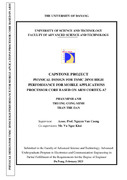
Please use this identifier to cite or link to this item:
http://thuvienso.dut.udn.vn/handle/DUT/5865| DC Field | Value | Language |
|---|---|---|
| dc.contributor.advisor | PGS.TS.Nguyễn, Văn Cường | en_US |
| dc.contributor.advisor | Vũ, Ngọc Khôi | en_US |
| dc.contributor.author | Phan, Minh Anh | en_US |
| dc.contributor.author | Trương, Công Minh | en_US |
| dc.contributor.author | Trần, Thế Dân | en_US |
| dc.date.accessioned | 2025-04-04T07:58:19Z | - |
| dc.date.available | 2025-04-04T07:58:19Z | - |
| dc.date.issued | 2023 | - |
| dc.identifier.uri | http://thuvienso.dut.udn.vn/handle/DUT/5865 | - |
| dc.description | 100 tr. | en_US |
| dc.description.abstract | An Application-Specific Integrated Circuit (ASIC), a type of integrated circuit that is specifically designed for a particular application or purpose, can be found in almost any modern electronic devices. Every ASIC need a processor to operate which ARM CORTEX is the most suitable processor currently due to its variable applications from low-power consumption, high-performance to specified implementation AI, automation, etc.… The design of processor core is required more and more difficult as the size of transistor continue to shrink, and the supplementary functions integrated all in one chip. On top of that, power and speed (performance) are the two biggest obstacles that affect the system's profitability. Successfully producing an ASIC necessitates a well-developed process with numerous intricately correlated steps, of which Physical Design is one. Physical Design, which is a step of the standard design cycle which accompanies after the Circuit Design, transforms a circuit description in netlist into the geometric layout which represents the position of cells and routes for the interconnections between them and guarantee the function of the circuit. This step is usually split into several sub-steps, which include design, verification and validation of the layout. By Physical Design, the designers determine the operation frequency, area and power dissipation of the design. These criteria mainly depend on the technology libraries that are provided by the fabrication houses. Technologies are commonly classified according to minimal feature size, i.e., 90nm, 65nm, 45nm, 28nm, 22nm, 18nm, 14nm, etc.…. In this project, we concentrate on Physical Design of ARM Cortex-A7 which is a 32-bit microprocessor core licensed by ARM holdings implementing the ARMv7-A architecture. By applying Physical Design, we introduce new layout design of processor core based on ARM Cortex-A7, which is not only narrow the data transmission time of the internal signal hence improve the performance but also optimize the area of the design. The target 1GHz is achievable with TSMC 28nm technology used for this project. | en_US |
| dc.language.iso | en | en_US |
| dc.publisher | Trường Đại học Bách khoa - Đại học Đà Nẵng | en_US |
| dc.subject | Physical design | en_US |
| dc.subject | Mobile applications | en_US |
| dc.subject | Arm cortex-a7 | en_US |
| dc.title | Physical design for tsmc 28nm high performance for mobile applications processor core based on ARM cortex-A7 | en_US |
| dc.type | Đồ án | en_US |
| dc.identifier.id | 2.DA.FA.23.098 | - |
| item.fulltext | Có toàn văn | - |
| item.grantfulltext | restricted | - |
| item.openairecristype | http://purl.org/coar/resource_type/c_18cf | - |
| item.languageiso639-1 | en | - |
| item.cerifentitytype | Publications | - |
| item.openairetype | Đồ án | - |
| Appears in Collections: | Khoa Khoa học Công nghệ tiên tiến - Điện tử Viễn thông | |
Files in This Item:
| File | Description | Size | Format | Existing users please Login |
|---|---|---|---|---|
| 2.DA.FA.23.098.Phan Minh Anh.pdf | Thuyết minh | 6.04 MB | Adobe PDF |  |
CORE Recommender
Page view(s) 20
34
checked on Nov 13, 2025
Download(s) 50
2
checked on Nov 13, 2025
Google ScholarTM
Check
Items in DSpace are protected by copyright, with all rights reserved, unless otherwise indicated.